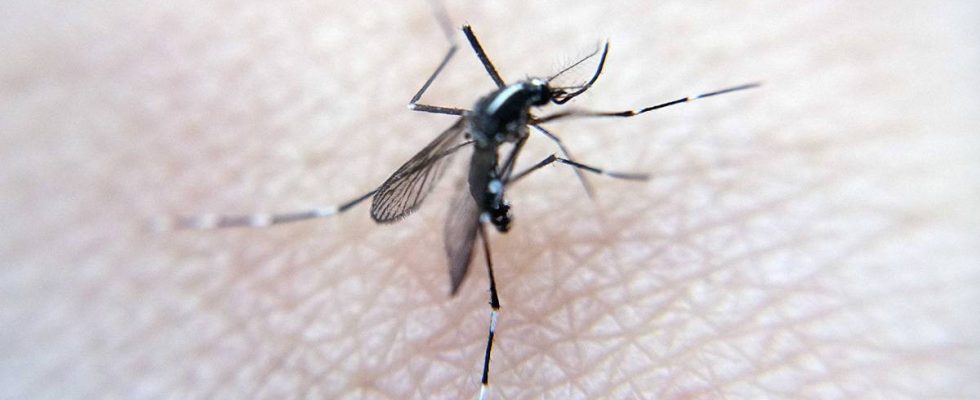They drive us crazy, with their little ringing in the ears and their bites which, in addition to itching, can transmit certain viruses. But the tiger mosquitoes haven’t finished harming us. In the years to come, we must expect an increase in cases of dengue fever, Zika and chikungunya, arboviruses transmitted by these “vector” mosquitoes, which are now widely established in the territory, warns the Risk Monitoring and Anticipation Committee toilets (Covars).
In an opinion published on Wednesday, the former scientific council recalls that the French tropical territories are confronted with it on a recurring basis. But in recent years, the metropolis has recorded a growing number of indigenous cases (that is to say not from contamination outside the territory) and outbreaks. In question, the mosquitoes Aedes aegypti and Aedes albopictus, or tiger mosquitoes, which proliferate in favor of global warming.
“Inevitable” progress
Since 2010, the number of colonized metropolitan departments has multiplied by ten: 67 to date. And last summer, the metropolis experienced 65 cases of autochthonous dengue fever, recalls the Covars. No serious form of the disease has been observed, unlike the overseas territories.
“The increase in cases is inevitable due to the increase in travel and climate change, noted entomologist Didier Fontenille, one of the authors of the report, during a press briefing. Soon, all of France will be affected by the tiger mosquito. As for Aedes aegypti, it is resistant to insecticides, these are two very bad news”. According to Covars, these viral diseases “could become public health problems in mainland France”.
An effect of global warming
If the Covars recalls the role of climate change, it is because the rise in temperatures favors the colonization of new territories for these pests recognizable by their black and white stripes. A concern shared by the World Health Organization (WHO), which believes that “climate change has played a key role in facilitating the spread of mosquito vectors”, said Wednesday Raman Velayudhan, who coordinates the initiative of the WHO on dengue fever and arboviruses.
How ? “The mosquito is a cold-blooded organism, it is unable to regulate its internal temperature. So the hotter it gets, the more it will be able to develop in higher latitudes, and have new colonization areas, explains to 20 minutes Anna-Bella Failloux, entomologist specializing in arboviruses and vector-borne diseases at the Institut Pasteur. Initially, he was confined to the south-east of France. But it goes up and inevitably, it will soon be present in all the departments of mainland France. Therefore, it is enough for people who have traveled to areas of the globe where these viruses are actively circulating for metropolitan France to be exposed to an epidemic risk. We will have a combination of two factors: a tiger mosquito present in high density, well adapted to the metropolitan environment, and an increase in the introduction of viruses linked to travel. An explosive cocktail.
Another ingredient is added: “When the female mosquito takes blood from someone sick, the virus is not digested in her stomach. It will infect all its internal organs and end up in the salivary glands, and can be released in the saliva of the female who will bite every 5 to 7 days, details the entomologist. However, the process of multiplication of the virus in the mosquito will depend on the temperature: the hotter it is, the more it is accelerated. Thus, if it takes about ten days for the dengue virus to reach the salivary glands when it is 25-28°C, if it is warmer, this period is shortened to seven days. We’re going to have more tiger mosquitoes, and more that will be infectious if they bite sick people. So no more cases.
“We must take the risk seriously”
Something to worry about the Covars. The forthcoming organization of major sporting events, including the Olympic Games in Paris in 2024, which generate significant population migrations, “reinforces the risk of occurrence of outbreaks of dengue fever, Zika and chikungunya”, he believes. The same concern emerged in 2016 during the Rio Olympics, with Brazil then “in the midst of a Zika epidemic, recalls Anna-Bella Failloux. The question of canceling them arose, but they were maintained, thanks to an effective vector control campaign. And there was no dissemination to the rest of the world. The situation is less critical in France, there is no epidemic, but we must remain vigilant”.
Because if France has a system of surveillance, detection, and management of these “efficient” diseases, it remains “improveable”, in particular in mainland France, estimates the Covars. In particular, there is a lack of “national coordination” making it possible to be informed of the situation in other regions. “We are not in a disaster scenario, but we must take the risk seriously through prevention campaigns or better organization,” concluded the president of Covars, Brigitte Autran.
A “means-dependent” struggle
In practice, “we are less prepared to face and eliminate these tiger mosquitoes than the overseas territories, because we do not have this education in the face of mosquitoes. But there is the “plan to prevent the spread of chikungunya, dengue fever and Zika“, set up several years ago, and which works well. We are efficient in the detection of the first cases, there is traceability and a link between all the actors, from the city doctor to the analysis laboratories, from ARS to the mosquito control teams: there is an operational “pipeline. All the systems can be improved, but we are doing well”.
To improve things, “it’s always means-dependent, underlines Anna-Bella Failloux. It is necessary to continue the reflection, but to match it with means, otherwise it is useless. The Covars laid the foundations for an effective policy. And it’s the right time to do it: we don’t ask ourselves all these questions when the pandemic has already broken out, but upstream, because we are bad at anticipating. Covid-19 has highlighted the issue of asymptomatic cases and its effects on the pandemic. Now is the time to act “.

